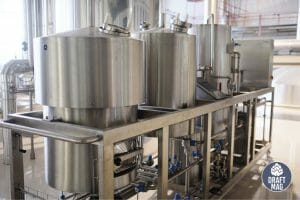Beer Calories: The Reason Behind Your Increasing Waistline
 Beer Calories and waistline have an overt relationship. Despite several attempts at weight loss, do you still find yourself stuck at the same number on the weighing scale?
Beer Calories and waistline have an overt relationship. Despite several attempts at weight loss, do you still find yourself stuck at the same number on the weighing scale?
If your answer is yes, the reason might be the ice-cold glass of beer in front of you.
This article will provide you with an insightful perspective on the calories, carbohydrates, and alcohol contents in your beer.
How Many Calories in a Beer: Your Favorite Beers
Here is a list of the overall calories in your favorite boozy beverages:
– Budweiser
Brewed by Anheuser-Busch, Budweiser is one of the topmost brands preferred by beer drinkers and has multiple locations spread across the U.S. This medium-bodied American-style lager is brewed with hops and rice along with the basic beer ingredients.
Both the can and bottles of Budweiser are 12 ounces. The calorie count is 145 to 147 in a pint of 12 ounces.
– Coors Light
Introduced in 1987 by the Coors Brewing Company, Coors Light was the answer for all the health freaks. As suggestive from its catchy tagline “Cold as the Rockies,” Coor Light uses the water of Rocky Mountain springs along with hop extracts and corn syrup. A 12-ounce serving of the Regular Coors has 149 calories.
Here is the caloric bifurcation of a 12-ounce can:
- Calories: 102
- Carb: Five grams
- ABV: 4.2 percent
– Heineken
The most iconic, one of the top-seller, green bottles of Heineken is made with a unique kind of yeast. According to the brand’s official website, about 25 million beers are served daily.
The Heineken Original bottle or 12-ounce can contain the following:
- Calories: 142
- Carbohydrates: 11 grams
- ABV: Five percent
– Hoegaarden
First brewed in 1445 by the monks of the Hoegaarden (spoken as WHO-garden) area, this beer hails from Belgium. This beer has a well-documented history which states that the monks used to add orange peels and coriander to the wheat beer, which led to the discovery of the famous recipe of this.
Today, around 90 percent of wheat beer that comes from Belgium is by Hoegaarden, and the brand sells across Singapore and China along with Europe and America.
Since Hoegaarden contains wheat and barley, it is not gluten-free. A bottle of Hoegaarden serving 12-ounce contains:
- Calories: 159
- Carbohydrates: 11.7 grams
- ABV: 4.9 percent
Top 20 Beers and Their Calories
The top 20 beers and their calories are arranged in ascending order, from the least caloric beer to the most, for every 12 oz serving.
- Ale beer has 124 calories per 12 ounces of serving.
- Malt beer has 131 calories per 12 ounces of serving.
- Lambic beer has 140 calories per 12 ounces of serving.
- Mild beer has 142 calories per 12 ounces of serving.
- Ginger beer has 149 calories per 12 ounces of serving.
- Helles beer has 150 calories per 12 ounces of serving.
- Brown Ale has 160 calories per 12 ounces of serving.
- Dark beer has 163 calories per 12 ounces of serving.
- Lager has 170 calories per 12 ounces of serving.
- Berlin Weisse has 175 calories per 12 ounces of serving.
- Bitter Beer has 180 calories per 12 ounces of serving.
- IPA has 181 calories per 12 ounces of serving.
- Pale ale has 182 calories per 12 ounces of serving.
- Dry cider has 190 calories per 12 ounces of serving.
- Porter beer has 209 calories per 12 ounces of serving.
- Stout has 210 calories per 12 ounces of serving.
- Sweet Cider has 220 calories per 12 ounces of serving.
- Quadrupel has 300 calories per 12 ounces of serving.
- Lager premium has 338 calories per 12 ounces of serving.
- Vintage Sweer Cider has 580 calories per 12 ounces of serving.
Beer Calories and Belly Fat: Is Beer High in Calories?
 Yes, they are. This brings us to the question of the hour- how many calories in a beer is standard? When it comes to beer, the simple logic is the more alcohol, the more calories. The higher the carbs and alcohol content in beer, the lesser the nutrient value.
Yes, they are. This brings us to the question of the hour- how many calories in a beer is standard? When it comes to beer, the simple logic is the more alcohol, the more calories. The higher the carbs and alcohol content in beer, the lesser the nutrient value.
That is one of the many reasons beer is not a potential beverage for diet-friendly people. Here are the reasons beer makes you gain weight:
– Increase in Calorie Intake
If you drink beer regularly, there are chances you have fat specifically around your belly. Beer contains as much sugar as a soft drink which adds a lot of calories. Studies have concluded that drinking alcohol increases one’s appetite, meaning you would want to indulge in eating more, leading to weight gain.
The calories gained from alcohol cannot be compensated by eating less. Thus, more beer leads to cascading effects, eventually increasing your weight.
– It Slows Down Liver Functions
When you drink alcohol, the body processes it differently than other substances. That glass of beer goes straight to the bloodstream, followed by the liver. Interestingly, half of the alcohol is absorbed within minutes, and the remaining in about an hour. This process is fast-tracked if you drink on an empty stomach.
Our body gives this special treatment to alcohol because it is a toxin. Therefore, the body aims to take it to the liver as soon as possible. Being the detox plant of our body, the liver can only break one unit of alcohol by the hour.
The leftover amount goes back directly into the bloodstream. Until the liver can process another unit of alcohol, it circulates in the body, damaging other cells.
While the liver deals with this procession, it is disturbed and is unable to perform the other functions it is supposed to. Consequently, there is a build-up of fatty substances, often responsible for “fatty liver,” which is the initial stage in many liver diseases.
Often seen in heavy drinkers, fatty liver prevents the liver from functioning properly. If the drinking continues, the liver cells eventually die, leading to irreversible cirrhosis.
– Prevent Burning of Fat in the Body
Since the body prioritizes the breaking down of alcohol over other substances, it takes time to burn the stored fat.
When you drink beer, you also consume calories; this makes it altogether a difficult task for the body to burn fat. Although, drinking in moderation can be a solution to this problem.
– Phytoestrogens in Beer
Hops are added to the brew to make different and unique beers. For this, the flowers of the hop plants are used. The hop plant is high in phytoestrogens. Due to this, there is a probability of beer causing hormonal changes in men and increasing the risk of belly fat.
However, it is essential to note that drinking casually and in moderation will not drastically increase estrogen levels in males.
The Science Behind Your Favorite Drink
This alcohol and carbohydrate content plays a significant role in determining the number of calories in beer. This is because the liquid calories add up faster.
Scientifically speaking, the grain used in the brew stores the carbs in the form of starch– the large sugar molecule kind. The sugar molecules are broken down into pieces during the brewing process by the natural enzymes contained in malted barley.
Although the small sugar pieces are transformed into alcohol with the help of yeast, the larger ones remain the same. The leftover carbohydrates add up to the calorie count of beer.
In the case of low-cal beers, there are enzymes in the fermentation process, which help break down the starch into simple sugars. Since there are no carbohydrates left and the alcoholic content is lesser, there is a decrease in the total caloric ratio in such beers.
This is why the light beer calories are significantly lower than the regular beer, even if it is from the same brewery.
Drinking Tips To Stay Healthy
A pint of lager contains as many calories as a regular packet of chips. Although it might seem nominal, in actuality, it has quite a drastic impact on your weight. Here are a few tips for you to maintain your weight goals and live a healthy life:
– Do Not Drink on an Empty Stomach
Eating a meal before going out to drink will line your stomach and slow down the absorption of alcohol in the bloodstream. This will ensure that the alcohol does not cloud your judgment or rattle you to make decisions that can affect your waistline.
– Avoid Consuming Beer With Food
It is a common practice to consume beer with meals. However, if you eat and drink, you will be consuming more calories as well as fats.
– Slow Down With the Drinks
it is better to limit yourself to one unit per hour. This is beneficial not only for your weight but also for your liver. If you go faster than the liver can handle, it will lead to inebriating effects.
Make sure you watch out for calories in a bottle of beer before pouring it down that pint every 20 minutes.
– Keep Up With a Healthy Lifestyle
Apart from limiting your alcohol intake, it is also essential that you live an active life, including eating healthy and making better choices for your body by inculcating exercises in your daily routine.
– Do Not Get Carried Away
Moderation is the key to maintaining your desired waistline and controlling your caloric intake. Often, people do not realize when one can become five. While you hang out and unwind with your friends, keep a tab of the calories in a can of beer which is about 150.
– Try Non-Alcoholic Beverages
Every once in a while, you should abstain from beer or any other kind of alcohol. Opt for non-alcoholic beverages, and give your body a refreshing break. This has many benefits, from slowing you down in alcohol consumption to reducing that hangover threat.
– Steer Clear From “Premiums”
Strong vintage cider and lager have a heftier impact in terms of alcohol and calories.
Labeling of Alcoholic Beverages: The Need for Transparency
The calories in beer are a matter of great concern, which is often overlooked. When you pick up an alcoholic drink, the nutritional facts just aren’t there. Moreover, not many are aware of the caloric content in alcoholic beverages, including beer and wine.
This is because breweries are not required to disclose the calories and ingredients in their cans and bottles, unlike food companies.
Despite significant attempts of the public health community at pushing for a change, there has been minimal action. The Center for Science in the Public Interest has been attempting transparency in the labeling of alcoholic beverages. This also involves the breakdown of nutritional value at the back of alcoholic beverages after being presented with evidence of obesity.
– Actions Taken
Recently, there has been a step in this direction after some national breweries such as Anheuser-Busch and Heineken USA decided to publish nutritional information on their new labels.
But this take is voluntary and left to the breweries’ discretion, which only includes their calorie count and not the ingredients used in the brewing process. This makes any alcoholic beverage just a can of sugar and fat with many unknown substances and added flavors.
Conclusion
 While popping a chilled can of beer, we all crave the refreshing sensation after the first sip. But not many consider the calorie quotient.
While popping a chilled can of beer, we all crave the refreshing sensation after the first sip. But not many consider the calorie quotient.
Alcoholic beverages, in general, have more caloric content.
Here’s a recap of what we’ve learned:
- When it comes to beer, the simple logic is: the more alcohol, the more calories. The higher the carbs and alcohol content in beer, the lesser the nutrient value.
- It is better to limit yourself to one drink per hour and avoid consuming beer with food.
- The calorie counts of commercial beers range from 140 to 155.
If you are on a watch out for your waistline, make sure that an ice-cold bottle of beer does not deter you from your goals. That being said, everything works best when done in moderation, and so does enjoying your beer.






